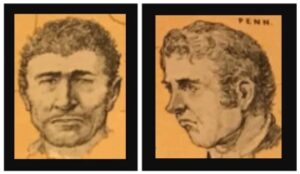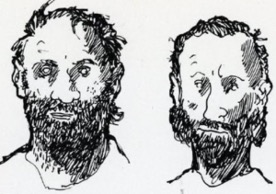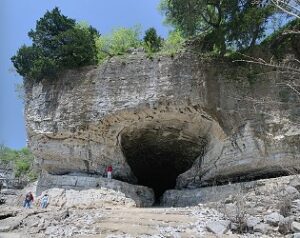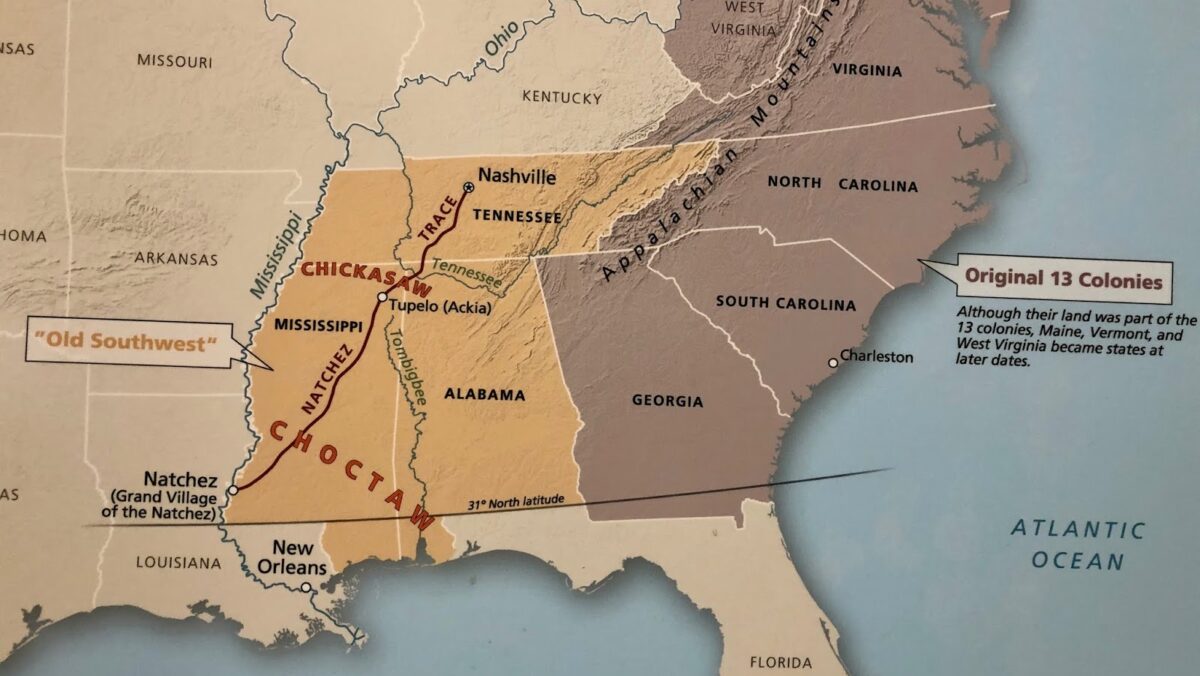At the turn of the Eighteenth Century, America, as a nation, was in its infancy and still largely unexplored, though the Lewis and Clark Expedition would soon shed much light on what lay out there across the wide continent. Soon to follow were the mountain men who trapped beaver and deeply explored the mountainous Far West. Yet the vast interior, between the Alleghanies and the Rocky Mountains, was still sparsely inhabited and little known except by the Native American tribes who didn’t take kindly to uninvited white pioneers bent on stealing their lands. There also were other new inhabitants arriving who had a decidedly sinister air about them and were on the prowl, searching for loot and mayhem.
Editor’s Note: I’m exceptionally pleased to put longtime RevolverGuy reader Clay Spencer in the spotlight this week, with his outstanding story about the badmen of the early Natchez Trace. Although this study predates the revolver era, it’s still a good fit for our pages, as it taps into the strong historical vein running throughout RevolverGuy. Additionally, as Clay explains, future generations of revolver-armed badmen, with names all of us would recognize, would soon roam this same area. I’m grateful that Clay shared his talents with us here, and know you’ll enjoy his outstanding work as much as I did. Welcome aboard, Sir! –M.W.
A Lawless Wilderness
Because of the raw emptiness of the region, law enforcement was almost nonexistent and the dangers were constant from man and beast, only the foolish—and likely soon to be deceased—entered the frontier alone, without arms and the ability to use them.
Weapons of the era consisted of muzzleloading black powder long guns and handguns, primarily of one barrel, with flintlock ignition. Those were not the most reliable firearms; they regularly misfired and were slow to reload, particularly those with grooved bores. Some savvy frontiersmen and travelers carried multiple charged single-shot pistols, a precursor to the New York reload, to pop more than one round at their adversaries. Still, once the guns were empty, or failed to fire, the outcome of the remainder of the fight came down to edged weapons or bludgeoning fists and feet.
American settlers who ventured into the interior of what today are the states of Ohio, Illinois, Kentucky, Tennessee, Missouri, and Arkansas –which in the late 1700s was the Wild West–were hardy types. What many lacked in formal education, refined manners and wealth, they made up for it with survival skills, a sense of confidence and pride in being able to take care of themselves and get by in difficult environments. They also could be extremely violent when maligned by their peers or assaulted by criminals.1
Among the principal “highways” for frontier travel and criminality in the early days of the interior were the interconnected Ohio River, the Mississippi River and the Natchez Trace. Taken as a whole, they formed a very long semi-triangular-shaped sinkhole infested by a lineup of cutthroats over several decades.
Ripe for Pirates, Renegades & Scalawags
A wealth of natural features and its isolation made the region attractive to lawbreakers, many of whom had fled the more settled Eastern Seaboard. There were numerous limestone caves useful for hideouts. Small islands dotted the Mississippi and Ohio rivers, the latter had its own notorious cave described below. The Natchez Trace was a primitive, narrow dirt trail that bordered cypress swamps, dense canebrakes and forests, running more than 400 miles between Nashville, Tennessee, to Natchez, Mississippi. It was a particularly dangerous pathway for travelers and merchants, ripe for ambush while on their way back from selling goods and produce in Natchez and New Orleans.2 A few crude inns offering shelter and food dotted the Trace for sojourners, but outlaws also frequented them, searching for victims to rob and kill.3

By the late Eighteenth Century, the quasi-triangular region of the two mighty rivers and the Trace was a virtually perfect hunting ground for deranged murderers, robbers and rapists to carry out their activities virtually unchecked. In some cases, though, when caught criminals were very harshly punished. Few citizens were bothered by such rough justice; indeed, most enjoyed the spectacles.4
Except for sporadic and mostly ineffectual ad hoc posses, there was no permanent organized force to oppose the brigands lurking in that part of the country. The most prolific desperadoes were the pirates who operated on the two big rivers and preyed on families and merchant crews polling flatboat rafts. One of the worst places was Cave-in-Rock, on the north side of the Ohio River, in present-day southern Illinois, which will be discussed in more detail concerning two particularly depraved blackguards. In any case, the gaping cave was a preferred location for pirates who made use of attractive women confederates in phony distress to lure unsuspecting flatboat crews. When the vessels reached the shore, pirates swarmed them, slaughtered everyone and stole their possessions.
For this short article, however, the bulk of the story will pertain to two infamous woodsmen who are usually credited as being our nation’s first known serial killers.
Two-legged Hyenas
Associated at times with land and river pirates were two presumed psychopaths: Micajah “Big” Harpe and Wiley “Little” Harpe, thought to be brothers but who may have been cousins. 5 “Big Harpe” was a hulking, simian brute while the smaller and younger “Little Harpe” was ferret-like but seemingly smarter and perhaps even more diabolical than his partner. He may have been the “brains” of the outfit.


Although the historical records regarding the background of the Harpes vary depending on sources (which include a lot of folk tales), it appears the two were of Scottish ancestry and lived in North Carolina. Farming was their main occupation, but they aspired to be slave overseers, jobs that would have meshed well with their aptitude for incipient brutality. Instead, the American Revolution erupted and the Harpes aligned themselves with the Loyalist (pro-British) side against the Patriot (anti-British) colonists. That allegiance didn’t win the Harpes any popularity contests with their Patriot neighbors, an excuse the Harpes later used to justify their violent criminal careers. Whatever the true reasons, their affinity for England was minimal at best and their military service mostly was of the irregular kind, that is, guerrilla raids on unprotected farms, consisting of looting, rape and murder.
Around the time the British surrendered in 1781, the Harpes had had a long taste of butchery and began living with a band of Cherokees who practiced a similar lifestyle. The duo and their hosts attacked isolated homesteads, typically murdering everyone present. Over time the two ruffians added women—kidnapped and voluntary–to their little band as concubines. Normal relationship boundaries did not apply; the women were shared indiscriminately as “wives” by the two men. When the bedraggled women became pregnant, it was not clear who the fathers were. It made no difference to the Harpes. Once, when Big Harpe grew tired of his—or was it Little Harpe’s? –squalling infant daughter, he smashed the baby’s head into a tree trunk and tossed away the remains.
By the late 1790s the Harpes, accompanied by their small harem, were dedicated roving serial killers operating over a wide area, with no allegiance to any cause or country. By and large, their victims’ money and property didn’t matter to them; they just seemed to enjoy spree-murdering people. But when they did steal things those were items they needed: horses, firearms and food.
Whatever one thinks of the Harpes’ behavior—and it was truly ghastly–they were very skilled woodsmen, dangerous and ruthless fighters, and hard to track. They evaded and outdistanced with ease posses and militia groups searching for them and lived off the land in a way that would put today’s survivalists to shame. The two maniacs were captured a couple times but with animal-like cunning they quickly escaped. Without warning they could appear far away from where they were last seen and resume their merciless attacks. Settlers and travelers in the region were terrified of these troglodytes, and rightfully so. But it seemed impossible to locate and put an end to the bloodthirsty villains.
Unabated Horrors
No one knows precisely how many people the Harpes murdered. Estimates range from about 20 to 50 but even the higher number could be too conservative. Most of their killings occurred in remote areas and many of their victims’ remains were never found. A specialty of theirs (adopted by other highwaymen and pirates) was disemboweling their victims’ corpses and filling the cavities with rocks. Once completed, the Harpes would sink the bodies either in a swamp or a river. Sometimes though, the bloated, rotting remains floated to the top and were discovered by passersby. Of course, many cadavers never surfaced or were discovered. The victims’ families and friends never knew what had happened to them.
For a short while the Harpes hooked up with chief river pirate and all-around bad guy Samuel Mason and his crew of reprobates at Cave-in-Rock.6 Mason and his band were far from shrinking violets but even they had not encountered sadistic degenerates like the Harpes who enjoyed devising sickening ways to torture and murder captives. On at least one occasion—and there may have been others– the two fiends tied a male captive naked to a horse and whipped the animal till it leaped off a cliff high above the cave. The pirates below heard the Harpes’ maniacal laughter as the horse and its shrieking rider splattered on the rocks below. Not even the hard-hearted Mason gang could stomach that level of cruelty and banished the Harpes from their encampment. It may have led to the eventual grim denouement for Mason and Little Harpe.

Spinning out of Control
Increasingly, desperate hues and cries rang out on the frontier to put an end to Big and Little Harpe. Anyone they met they slaughtered and mutilated: families, old folks, children, even helpless babies. At the same time, there was no doubt the killers were aware that vigilantes were searching for them and would not treat them kindly. Instead of forever departing the vast area, the two maniacs stepped up their random killings.
In the summer of 1799, the Harpes and their women were attacked by a group of men searching for them in western Kentucky. Little Harpe and the ladies scattered like quail and escaped but one of the posse men shot the mounted Big Harpe in the lower spine, paralyzing his lower extremities. Another man whacked him in the head with a tomahawk, and he tumbled off his horse. As Big Harpe lay immobile on the ground one of his pursuers, a man whose wife and child had been murdered by the Harpes, began to slice open his neck with a knife. Unrepentant to the last, Big Harpe supposedly bellowed, “You are a God damned rough butcher, but cut on and be damned!” Cut on the other man did, and he twisted off the outlaw’s head for good measure. Historical sources disagree, but the “trophy” was either jammed onto a sharpened tree branch or a stake in the ground. For many years afterwards the bleached skull greeted anyone who passed by and was a warning about what lay in store for badmen.

Time was also running out for Little Harpe. Meanwhile, a few years later, a reward was offered for anyone who captured river pirate chieftain Sam Mason. A man who called himself John Setton (or Sutton) and another rascal named Philip Alston showed up to collect the reward; they possessed a curious clay-covered lump that turned out to contain Mason’s head. How “Setton” and his buddy came to possess it is not known, but unfortunately for Setton someone recognized him as Little Harpe, and he and his partner were arrested. In early 1804, the two reprobates were hanged and then decapitated. In what seemed to be poet justice, their noggins were impaled on stakes and displayed on the Natchez Trace as a lesson to other evildoers.
Once free of the Harpes, the women who had traveled with them apparently resorted to living normal lives, and even married and had more children. One may wonder what they, later in their lives, must have thought about their misspent time with the Harpes, and the barbarity they had witnessed, but likely they didn’t dwell on it.
Musings
After the demise of the awful Harpes, lawbreaking in the nascent “Wild West” continued and expanded. As the nation pushed westward, increasingly opportunistic and better organized outlaws migrated there and proliferated, and they in turn attracted the same ilk. In fact, a loosely connected criminal lineage existed between river pirates, counterfeiters, master criminal John Murrell, border guerrillas before and during the Civil War, the James and Younger Gang, the Dalton Gang, early 20th century bootleggers, and gangsters such as John Dillinger, “Pretty Boy” Floyd and many others. But none was as grotesque as the Harpes. If there had been at least some organized crime prevention in the region those serial killers might have been terminated much sooner. Instead, the job was left up to everyday citizens who for the most part struggled to “regulate” the savage riffraff. But when citizens did get their hands on criminals, the punishment often was frightful, and final, as it certainly was for the Harpes.
It would take generations before the creation of a modern professional American police force that could effectively thwart organized lawbreakers and maniacal thugs. Oddly, since the early 2020s, it’s become popular with some soft-on-crime apologists to “defund the police” and essentially end law enforcement. Apparently, those people don’t know, or care about, the dark history of American frontier lawlessness and mayhem. Nonetheless, the pioneers of yore would have envied the level and quality of police protection that many citizens take for granted nowadays.
*****
endnotes
-
-
- Combatants sometimes put their “mark on a man” by gouging out an eye, biting off a nose or ear, or inflicting horrific facial lacerations.
- Both were founded by French colonists in the early Eighteenth Century.
- Centuries ago, much of the Natchez Trace was dark, enclosed and eerie, but when I traveled its entire length in the 1990s it was mostly a beautiful open parkway. Yet the remaining sections of the old Trace revealed how creepy it must have been in the past.
- Jails were scarce and not very secure during colonial times and later on the frontier, and serious physical punishment prevailed: public floggings, tarring and feathering, the pillory, cropping ears, branding criminals on their hands or faces (“T” for thief, “HT” for horse thief, “B” for burglary, “M” for manslaughter…) lynching, and other nastiness.
- Sometimes spelled “Harp.”
- Around twenty-five years ago, during a sunny day, I visited Cave-In-Rock and immediately experienced a deep sense of dread. I didn’t hang around for long in that eerie place.
-
Sources
Alexander, Kathy, (updated October 2023), The Vicious Harpes—First American Serial Killers, Legends of America, from https://www.legendsofamerica.com/we-harpes/.
Cox, James A., Colonial Crimes and Punishments, (Spring 2003), C.W. Journal, from https://research.colonialwilliamsburg.org/Foundation/journal/spring03/branks.cfm.
Isenberg, Nancy, (2017) White Trash: 400-year Untold History of Class in America, Penguin Books.
Rosa, Joseph G. and May, Robin, (1977), Gun Law: A Study of Violence in the Wild West, Contemporary Books, Inc.
Talbot, Tim, “Frontier Justice”, (2023), Explore Kentucky History, from https://explorekyhistory.ky.gov/items/show/606.
Wellman, Paul I. (1964) Spawn of Evil: The Invisible Empire of Soulless Men Which for a Generation Held the Nation In a Spell of Terror, Doubleday & Company.
Wellman, Paul I., (1961) A Dynasty of Western Outlaws, Doubleday & Company.
Willard, Michelle, (April 29, 2019), A Middle Tennessee Mysteries, Knox County: America’s first serial killers The Harpe Brothers, from https://www.middletennesseemysteries.com/article/482/knox-county-americas-first-serial-killers-the-harpe-brothers.
Featured image from: here


Great article Clay! This subject is one that deserves more attention in the history of crime and law enforcement in our country.
Paul Wellman’s genealogy of the outlaw gangs through out history from the era your article covers up through the depression era is fascinating.
Please keep your articles coming.
Thank you.
Mr. Spencer,
Thank you for a fascinating read! I hope you give us more material in future. Since my mid twenties I’ve found history more and more interesting. I think I needed some life experience to put it in perspective, or to relate… And it always helps to have an enthusiastic teller of tales!
Riley, we’ve got more from Clay in the queue and look forward to sharing more of his excellent work with the RevolverGuy audience!
Very interesting history Mr. Spencer! Our nation’s highways, and biways, rivers and trails are full of so much history that I think most people take for granted. Thank you for taking the time to bring us this story!
Lordy !! That was quite the trip back in time to Colonial crime sprees, of which I suspect there were a whole lot more than we’re aware of. Thank you for the time and research (and preparation) bringing these two knuckle draggers back from oblivion. The Harpes are just one of endless examples of those who choose to live on the evil and violent side. On the flip side, the Harpes didn’t get bail, lengthly trials and endless appeals. Fast justice, while sometimes slow coming, is usually best.
Organized policing didn’t appear until the early 19th Century with Sir Robert Peel in England, the model of which was later adopted in the U.S. and other countries. The philosphy of government operated paramilitary ‘to protect and serve’ (cough) has not run its course. The so-called ‘criminal justice’ system will not stop criminals and organized criminal enterprises from operating, and even flourishing. Capitol punishment won’t deter criminals, but it sure cuts down on repeat offenders.
Bottom line: A loaded revolver or two in your pockets beat the po-leece on a cell phone.
Good points, s. bond.
Lawlessness on the American frontier was, in my view, far worse than many modern historians care to admit, but as noted in my article when criminals were caught their punishment was often brutal. For instance, horse thievery, arguably comparable to today’s carjackings, was for a long time a hanging offense, and often carried out by impromptu “uplift societies”. Sad to say, some of those dealt with in that fashion were no doubt innocent.
England was considerably behind the curve concerning organized policing as compared to some western European nations like France. In fact, “police” is a French word, which in the 17th and 18th centuries supposedly meant “public order in a city.” Many 18th century European visitors to big English cities like London were appalled at the lack of professional police forces and the high rate of violent crime. In that bygone era England relied on “thief takers” who were basically bounty hunters. Many of them were corrupt, in league with criminals and ineffectual.
Why was England so behind the (European) times in regard to creating a modern police force? The real reason appears to be the citizens and their leaders were too cheap to pay for that kind of protection. But when certain punishment was coupled with the likelihood of being captured by trained police, English crime rates plummeted.
Thank you all for the responses. Obviously this is a “pre-revolver” historical piece, but as I eventually move into the nineteenth and twentieth centuries there will be articles concerning revolvers. Maybe semi-auto pistols and edged weapons, too.
Thank you for the fascinating read, Sir. It was a good reminder that we don’t have a corner on the “crazy market” in modern times. As long as there have been humans, there has been evil. Good guys, stay frosty!
Sociopathic behavior lurks not far below the surface of US society, as events in our increasingly violent cities show. And the glorification of outlawry in social and entertainment media fuels and ratifies such behavior, no matter how violent, sadistic and inhumane.
S. Bond’s bottom line is not wrong.
Great article and very interesting for history buffs. I am born and raised in Southern Illinois and live not too far from the small town of Cave in Rock. It’s well worth the time if your in the area to stop and take in the history. An interesting side note is that Cave in Rock was used as a filming location for the Jimmy Stewart portion of the movie “How the West Was Won”.
I think late actor Walter Brennan played the leader of the river pirates in the Cave-in-Rock scene.
We stopped at the Meriweather Lewis Nat Monument near, Hohenwald TN, where he was either murdered or committed suicide, they don’t know which. We drove the Natchez Trace Pky, the entire rout from Franklin Tn to Natchez Miss. We were traveling in RV’s. Natchez was beautiful. Looked at a lot of the old trace along the way and yes it was scary looking and out there. Could not imagine how out there it would have been back then. even today, Our Greenway, in Murfreesboro TN, is a dangerous place to walk, by oneself at times. All time hearing about strong arm, and other crimes on that thing. Great story Revolver Guys.
When I traveled the Trace and sections along the Ohio and Mississippi Rivers many years ago, pop pop, it gave me a sense of how remote and lawless that huge region was two centuries ago. If I were traveling in that area way back then I would have accompanied a large, heavily armed group. Yet many people did not and paid a terrible price.
I’m new to the site, but the content is fantastic. What a great article about life on the American frontier! Thank you for sharing!
Welcome aboard, Zach. Pull up a chair and stay a while. I’m glad you’re enjoying the content!
Great article! The Trace runs the entire length of the county where I live and my house is two miles from the Trace as the crow flies. During my 39 year LE career, there have been things occur on it that would make you realize how dangerous it must have been in the 1700/1800s.